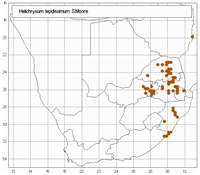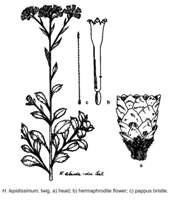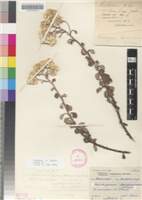Diagnostic characters:
Leaf margins serrateLarge headsLarge open branched inflorescencesCream bracts
Description:
Dense twiggy shrublet 100�600 mm high, lower branches often decumbent, rooting, all closely leafy, the younger parts loosely greyish-white woolly. Leaves mostly 7�30 x 3�15 mm, diminishing slightly upwards, usually broadly elliptic, rarely suborbicular, apex subacute to obtuse or rounded, mucronate, abruptly contracted to a flat petiolar part roughly � to � the total leaf length, base auriculate in larger leaves, margins more or less crisped, lightly and loosely greyish-white woolly above, wool glabrescent to reveal long coarse shaggy hairs, greyish-white woolly-felted below. Heads homogamous, campanulate, 4�6 x 3�5 mm, double that across the fully radiating bracts, few to many in corymbose clusters terminating the branchlets. Involucral bracts in c. 5 series, graded, imbricate, inner about equaling flowers, outer acute, inner more or less obtuse, crisped, glossy, white, creamy or pale straw-coloured. Receptacle with fimbrils at least equaling ovaries. Flowers 10�30, yellow. Achenes 1 mm, barrel-shaped, obscurely ribbed, glabrous. Pappus bristles many, scabrid, bases cohering by patent cilia.
Flowering mainly from April to August, but flowers can be found in any month.
Distribution:
Always in rocky places, particularly rocky mountain tops and cliff edges. H. lepidissimum ranges widely, from Dedza district and the Shire Highlands in Malawi to Inyanga in the E. highlands of Zimbabwe and Mt Gorongoza in Mozambique south to the Soutpansberg and Blouberg, the mountains of Mpumalanga and Limpopo including the Lulu Mountains and the Steenkampsberge, the Magaliesberg, Witwatersrand, Highveld, western Swaziland and the mountainous parts of N. KwaZulu-Natal and Zululand; south of the Tugela confined to Table Mountain Sandstone formations and recorded as far south as the S bank of the Msikaba River and Fraser's Falls in Pondoland, Transkei.
Grassland and Savanna Biomes.
Notes:
The chief distinguishing mark of H. lepidissimum is its leaves with crisped margins and upper surface eventually free of wool to reveal long shaggy hairs, green when fresh, brown when dried; in contrast, the leaves of both H. mimetes and H. rudolfii, its close allies, are persistently tomentose above and grey, with smooth margins.
Colour of the involucral bracts varies from white to cream to pale or deep straw-colour. Plants with white or straw-coloured bracts may grow together, though plants with white bracts are commoner on the Highveld and in the Soutpansberg than plants with straw-coloured bracts, and the opposite is true in KwaZulu-Natal. There is also some variation in size of heads, big-headed plants being commonest in the Soutpansberg and in the mountains of Mpumalanga.
Taxonomy:
Literature:
Helichrysum lepidissimum S. Moore in J. Bot., Lond. 31: 399 (1903); Moeser in Bot. Jb. 44: 311 (1910); Compton, Fl. Swaziland 630 (1976); Hilliard, Compositae in Natal 190 (1977).
Type:
Gauteng, Johannesburg, among sandstone rocks to northward, Rand 1294 (BM, holo.).
Synonym(s):
H. lepidissimum var. flavidum Moeser in Bot. Jb. 44: 311 (1910). Lectotype: Limpopo Province (Transvaal), between Pietersburg and Haenertsburg, Junod 515 (G).
H. gazense S. Moore in J. Linn. Soc., Bot. 40: 110 (1911). Type: Zimbabwe, Melsetter, Swynnerton 1853 (BM, holo.; K, iso.).
Vouchers:
Acocks 11592 (K; PRE); Codd 2872 (NU; PRE); Galpin 14889 (K; PRE); Hilliard & Burtt 10232 (E; K; MO; NU; S); Rogers 18854 (K; PRE).

_sml.jpg)
_sml.jpg)
_sml.jpg)
_sml.jpg)
_sml.jpg)
_sml.jpg)
